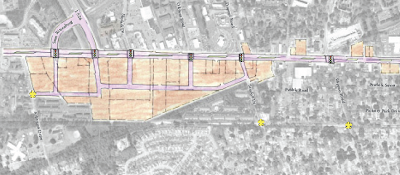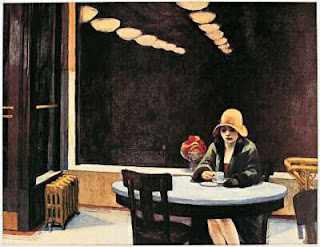In the first post about biking in downtown Danville, I chronicled the way land-use patterns tilt different parts of the same commercial corridor precipitously toward complete streets, or precipitously toward automobile only zones.
Southern downtown is frustrating, but the No Man's Land deal-sealer is the difficulty of negotiating its southern boundary. Biking in and out from the north is not the greatest, but after getting to the Iron Horse Trail, it is rather pleasant. To the south, though, there are two choices for leaving Dodge, both dangerous.
As an ardent suburban biker, I know the roads that are good, and the roads that are dangerous. #1 most death-defying, damn-I'm-in-a-tight-spot place: freeway overpasses with onramps. #2: high speed (40+) frontage roads with gravelly <4 ft shoulders. Let's mix some Homer with our Gunsmoke and call them Scylla and Charybdis. A closer look:
Scylla Sycamore: Anatomy of a Beast
The only way to get to the Iron Horse Trail from the south end of town is to use Sycamore Valley Rd as it passes over highway 680. The screen captures and photographs below illustrate the difficulty of this endeavor.
1) Southern edge of Danville Blvd/Danville shopping district/Dodge.
2) Street view:
No bike lane, and the sidewalk ends. A subtle signal about who is welcome. Beyond that ped dead-end, cars merge to the right at will and at speed onto a gently banked ramp to 680 south, regardless of what color the light is. No pedestrian crossing there.
3) Street view a little tighter in:
No pedestrian crossing, but hey: a bike lane! It's hard to see, but by the island (just left of the 680 sign), a bike lane emerges. It disappears across the intersection, and then reappears by the next island, then disappears, then reappears across the overpass, then disappears, etc. It's comical that someone thought that a now-you-see-it-now-you-don't four foot margin between freeway-aroused automobiles and a bicyclist would even be worth the paint.
 |
| O = bike lane, X = No bike lane |
A patchwork bike path described as such is misleading insofar as it implies that the object described is, in fact, a patchwork bike path. It fails to summon the agoraphobic terror one gets when biking across the gray expanse of what is not technically an intersection, but rather a space for cars to ascend to, or decelerate from, highway velocities triple and quadruple a bicyclist's. One feels as though there may as well be a bike path across a runway at SFO.
Of particular danger and high dexterity-need is the switch from the 2nd "O" to the 3rd "O" (L to R). One must cross a lane of cars, cars having just experienced the g-forces better known as the cloverleaf exit, cars with drivers having just tasted the anticipation of flooring it on the straightaway to even out a leftward-tugging centrifugal force, cars that are supremely totally not expecting a bike to appear in front of them, nor prepared to brake for said bike.
One must reverse this maneuver as one moves from "O" the 3rd to "O" the 4th. Cars leave the overpass, and right-turning traffic moves into the dedicated, banked right hand lane. One must somehow move from the right of these cars (while on the overpass) to their left (@ "X" the 4th and "O" the 4th). While doing this, one must contend with new cars being added to the travel way from the off ramp near "X" the 4th.
The reward at the end is safe passage on the Iron Horse Trail/Ithaka. I only take this route, somewhat counterintuitively, at night, when traffic is lighter. Doing so requires waiting to verify an absence of headlights on the cloverleaf, and then pedaling like hell. Scylla. I avoid it.
Charybdis: The Choke Point
After the complications of Scylla, it's anticlimactically simple. Heading south, with Sycamore to the left, a biker follows a bike path for a hundred yards, and then a generously wide shoulder picks up the slack. So far so good, until the choke point.
The picture does not show that the 3 foot shoulder is rather gravelly, mostly inclined (heading south), or that the woosh of 45 mph cars is muy frightening. Whereas Scylla involves timing and a mad dash to the other side, Charybdis requires a sustained, disciplined sprint. Since I am not terribly fast (12-15 mph being my guesstimated cruising speed with a slight incline), this stretch takes about 4-5 minutes, but feels like 20. The uphill, devilishly, increases as you get to the end.
The risk comes from the speed differential between the hypothetical car and bicyclist. A professor of mine once showed the following chart (I do not know the source, but in addition to being a transportation planning lecturer, he is also a transportation planning consultant, so I trust it) to indicate the effect that vehicle speed has on crash mortality.
The numbers on the axes are difficult to read, but a vehicle-pedestrian crash at any speed over 30mph stands an excellent chance of causing a near fatal injury or death.
Check for Pt 3 of the Biking No Man's Land series, coming soon, in which I'll review a few potential fixes pipe dreams.





























